News Release

Canon Inc.
Tsuzuri Project to donate high-resolution facsimile of The Wind and Thunder Gods screens to Kenninji Temple in Kyoto Prefecture
TOKYO, November 5, 2020—Canon Inc. announced today that the Tsuzuri Project (officially, the Cultural Heritage Inheritance Project), a joint project organized by Canon and the Kyoto Culture Association (NPO), donated a high-resolution facsimile of "The Wind and Thunder Gods" by Tawaraya Sotatsu as part of the project's Stage 14. The facsimile was donated to Kenninji Temple in Kyoto Prefecture, and will be on display from November 5.
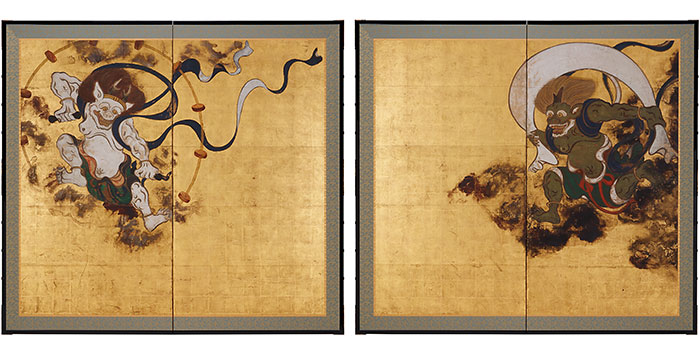
National Treasure "The Wind and Thunder Gods" (Tawaraya Sotatsu)
The Wind and Thunder Gods, whose original work is owned by Kenninji Temple and held in the collection of the Kyoto National Museum, is considered to be the crowning achievement of artist Tawaraya Sotatsu, founder of the Rinpa (Rin School), and one of the definitive works of Japanese culture. At the request of Kenninji Temple, the original is currently held in storage at the Kyoto National Museum and is only occasionally on display for public viewing.
The first high-resolution facsimile of the work, produced during Stage 4, was donated to Kenninji Temple in 2011, where it has since been on display for a large number of visitors from around the world. Now in Stage 14 and with the latest technology developed in the ten years since the first high-resolution facsimile was produced, the decision was made to create another high-resolution facsimile that is even more accurate to the original.
To produce the high-resolution facsimiles, the original work was photographed using a high-performance EOS R5 full-frame mirrorless camera, creating a high-resolution image with more approximately 4.2 billion pixels. Combining Canon's technical expertise in imaging, processing and output with the master craftsmanship of traditional Kyoto artisans, the original work is recreated down to the finest details, including dark clouds of ink against a background of gold paper, the fine grains of the pigment and delicate brushstrokes. What's more, thanks to improved accuracy of the project's independently developed color-matching system, high-precision color matching can be completed in a short time, helping to reduce wear on the original work and making possible the production of more faithful high-resolution facsimiles.
The high-resolution facsimile of The Wind and Thunder Gods, produced with state-of-the-art imaging technology, will be donated to Kenninji Temple on November 5. The donated facsimile will be installed in the temple and available for public viewing (admission fee required).
Through the efforts of the Tsuzuri Project, original works can be preserved in more ideal environments while their high-resolution facsimiles can be widely used for public display, allowing more people the opportunity to experience the works in person.
About the Tsuzuri Project
The Tsuzuri Project is a social contribution initiative organized by the Kyoto Culture Association and co-sponsored and promoted by Canon with the goal of preserving original cultural assets and creating high-resolution facsimiles. Combining Canon's technical expertise in imaging, processing and output with the master craftsmanship of traditional Kyoto artisans, the Project produces and donates high-resolution facsimiles of such celebrated historical Japanese cultural assets as folding screens, sliding doors and illustrated scrolls. As of this most recent work, the camera and equipment used in the process of creating the high-resolution facsimiles have been upgraded, and now includes an EOS R5 full-frame digital interchangeable-lens camera and Speedlite EL-1 flash unit. Thanks to this new equipment, the high-resolution facsimiles can be produced in better quality than ever before.
The Project began in 2007 with two objectives—to donate high-resolution facsimiles of Japanese art abroad to their original owners, and to create high-resolution facsimiles of historical cultural assets that appear in school textbooks for use as tangible educational materials to teach primary and secondary school students about Japan's history, art and culture. Different works from artists including Katsushika Hokusai, Tawaraya Sotatsu and Ogata Korin, have been selected every year since, with the work most recently donated as the Project's 58th facsimile.
For more information, please visit the official Tsuzuri Project website.
- *As of Stage 11, the Project utilizes a Canon EOS 5D Mark IV digital SLR camera and EF 400mm f/2.8L IS II USM lens. As of Stage 12, the Project utilizes an imagePROGRAF PRO-4000 large-format printer.
The Tsuzuri Production Process
Input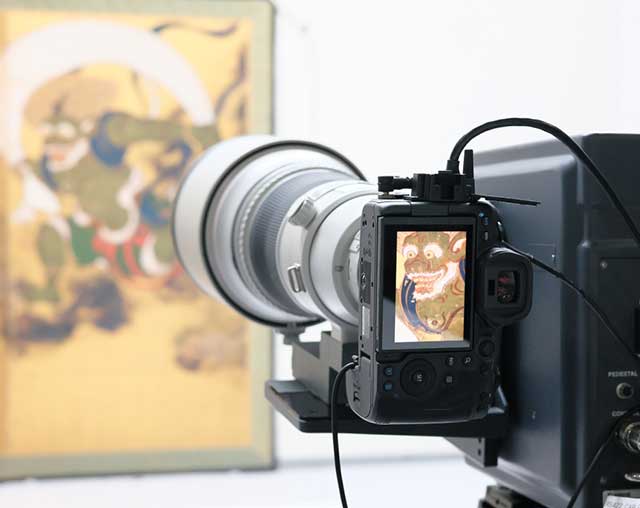 |
Capturing high-resolution digital dataA digital SLR camera is used to capture high-image-quality data for output in the actual size and dimensions of the original cultural artifact. The camera is mounted on a specially designed turntable, enabling it to capture segmented portions of the original work, which are then digitally stitched into a single high-resolution image file. |
Color matching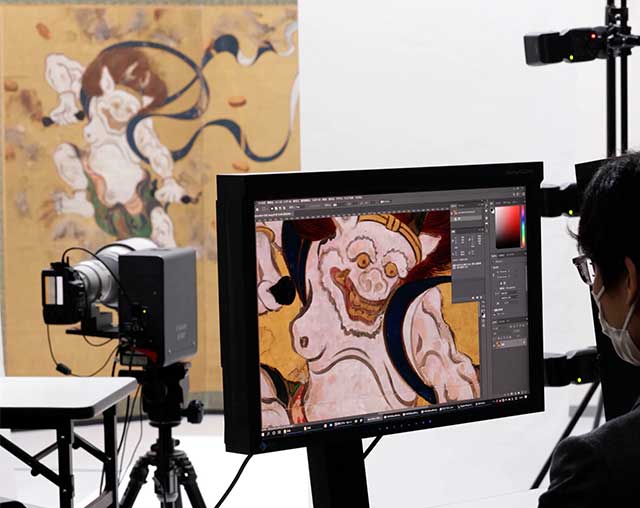 |
Highly accurate color matching systemThe high-resolution data is digitally processed using Canon's proprietary color matching system, which corrects for inherent differences in the lighting environment where the work was photographed. The image is printed and colors are matched on location, helping to minimize both technicians' workload and the wear on the original cultural artifact. |
Output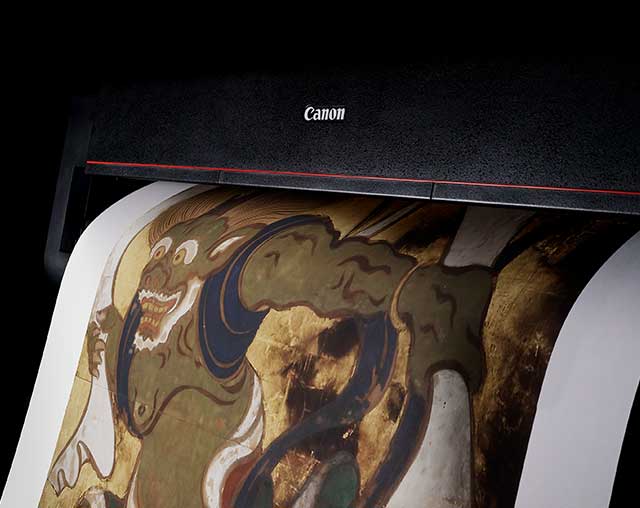 |
World's highest level of printing technologyJapanese art expresses a dimensional depth through its delicate tonal subtleties and shading. These are recreated using Canon's imagePROGRAF large-format inkjet printer, which outputs the data onto washi or silk paper that we have specially designed to be ideally suited for printing facsimiles of the cultural artifacts and applying such finishes as gold leaf. |
Gold leaf, gold paint & isinglass |
Reproduced through time-honored and traditional techniquesAuthentic Kyoto Nishijin craftsmen reproduce the most significant features used in Japanese cultural artifacts—gold leaf, gold paint and isinglass. Special "color fading" techniques recreate the effects that time has had on the gold leaf. |
Mounting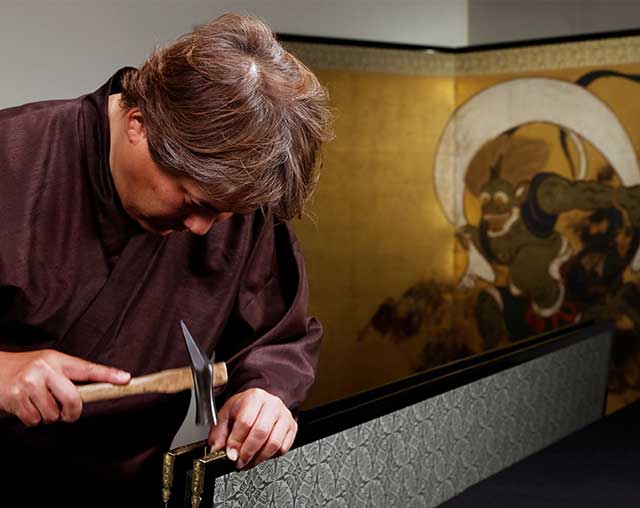 |
A discipline developed in KyotoA master Kyoto framer carefully mounts the output and finished facsimile using traditional Japanese tools. Great care is taken to recreate fading in the metalwork and fabric used in folding screens, while sliding door panels are installed exactly as they were in their original locations. |
- *Learn more about the Canon technologies used to create high-resolution facsimiles of cultural treasures in this video on the Canon website: https://global.canon/en/v-square/76.html
